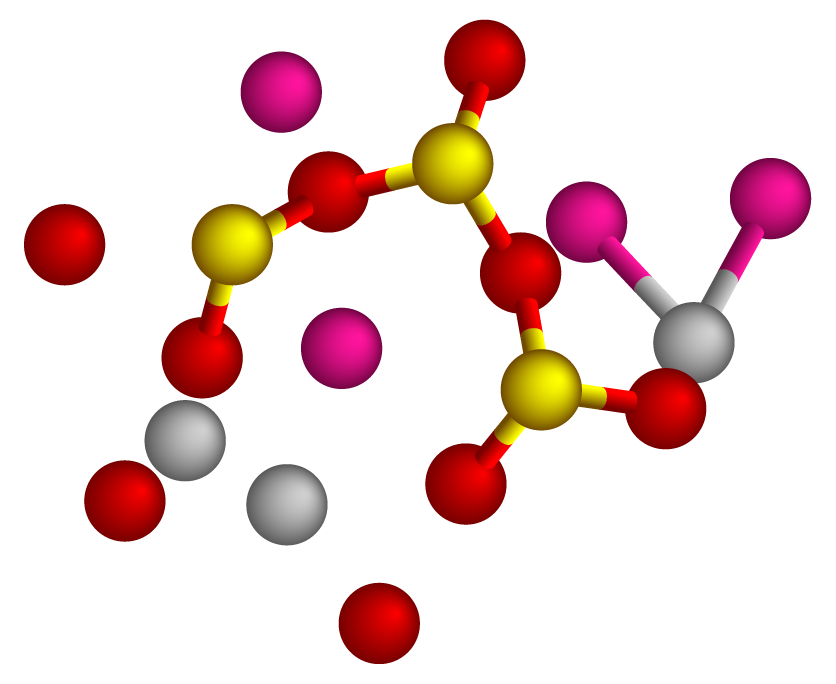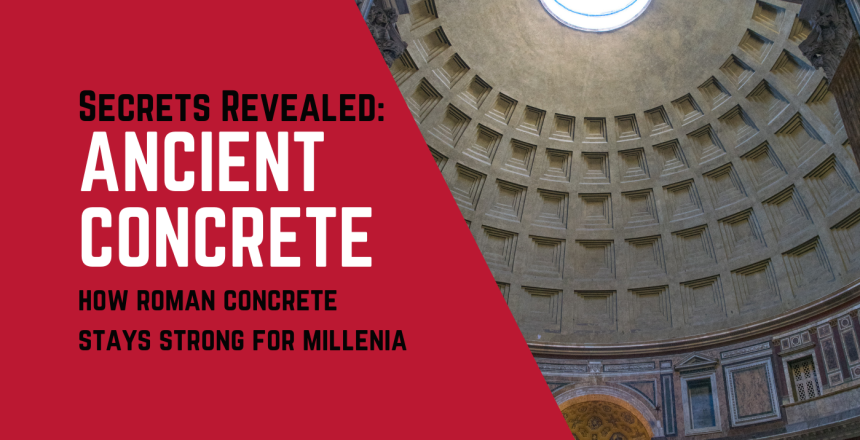We’ve known for centuries that Roman concrete was special. Until recently, its strength and durability were secrets lost to time. But with a new scientific study just this past year, we may have finally figured out the long-lost recipe for this self-healing concrete.
What Is Roman Concrete?
During the last two centuries BC, Rome began building with concrete to a prolific extent: aqueducts, temples, and monuments all utilized concrete as their central component starting around 150 BC. In the first century AD, Nero was said to have ordered the rebuilding of Rome with this foundational material. And even ports and submerged breakwaters used special formulas of what we now call Roman concrete to construct incredibly durable structures, even by today’s standards. But despite seeing records of these structures in writings from that time, very little was known about its composition.
Composition of Roman Concrete
What we did know about Roman concrete was limited: two ancient scholars, Pliny and Vitruvius, both made note of the unique properties of this concrete, as well as some basic information about its ingredients.
From their notes, we knew that this concrete consisted of volcanic aggregates (specifically, of pozzolanic ash) and coarse aggregates (typically rock, brick rubble, ceramic tile, travertine, and lime clasts) mixed with water. Another key component was often seawater, especially in maritime concrete.
According to Vitruvius in his Ten Books on Architecture, the ratio of one part lime to three parts pozzolana was ideal for air-exposed applications, whereas a 1:2 ratio was appropriate for underwater concrete structures.
But beyond this information, modern scientists and engineers had little else to go by for the unique properties that Roman concrete possesses.
Special Qualities
Not only does Roman concrete tend to provide better tensile strength than other unreinforced concrete, including some modern formulations, but it also has special self-healing properties. This self-healing concrete has allowed ancient aqueducts to continue serving modern cities, as well as leaving the Pantheon, the largest unreinforced concrete dome in the world, nearly untouched by centuries of exposure to weather, seismic activity, and environmental damage.
Even more intriguing is the fact that Roman concrete, when exposed to seawater, doesn’t crumble like modern reinforced concrete. On the contrary, it seems to only become stronger with exposure. This kind of resilience provides centuries of practical use, compared to modern concrete’s few decades before deteriorating.
If the code could be cracked, Roman concrete would change the face of construction.
The Mystery of Its Strength
Scientists have made many guesses as to the source of Roman concrete’s strength and self-healing properties. But the two most recent studies for this special material finally yielded applicable results.
In 2017, researchers from the University of Utah discovered that hot mixing, a technique that was particularly popular in 1st century Roman engineering, may have been a key part of the strength and durability of this self-healing concrete.
But in 2023, a multi-national team led by MIT and Harvard researchers uncovered the final piece of the mystery. And it wasn’t what many scientists expected.
FAQs about Roman Concrete
Roman concrete is an ancient formula of concrete that uses volcanic ash and lime-included aggregates. It is known for its strength and durability, as seen in structures like Rome’s Pantheon and many ancient aqueducts that are still in use today.
Until January of 2023, the recipe for Roman concrete was lost to antiquity. But a recent MIT and Harvard study uncovered the formula that makes this concrete so incredibly strong.
The two components of this concrete are coarse aggregates that include lime clasts, typically from native rock or from recycled building materials like tile and travertine, along with volcanic ash, specifically pozzolanic ash from the Bay of Naples.
The unique components of this concrete give it both self-strengthening and self-healing properties. Until recently, modern engineering had not been able to determine how these mixes achieved these unique properties.
In maritime concrete, the submerged volcanic ash would wash out and be replaced by strong crystalline structures, perpetually strengthening the concrete instead of tearing it apart.
In aerial concrete, the lime clasts acted as guides for naturally occurring fractures due to weather and exposure, allowing water to hydrate and mobilize the lime within.
The mobilized lime would then seep through the cracks and solidify as calcium carbonate, thus permanently sealing the crack and making the concrete even stronger.
- Eco-friendly properties
- More resistant to weather and moisture exposure
- Longer-lasting infrastructure
- Advancements in 3D printed concrete
An Ancient Technique, Not a Mistake
Decades of studying Roman concrete failed to take into account the importance of the lime used within the formula. In almost every sample, researchers noted the presence of large limestone clasts. While the rest of the aggregate was generally small and evenly mixed, these chunks of limestone stuck out like sore thumbs under microscopic inspection.

Why would Roman engineers have these massive pieces of lime in a fine aggregate? Was it poor mixing? That was the going theory for years. The assumption had always been that the limestone would be slaked (made into a paste) rather than raw, which followed the widespread process prior to the appearance of this new form of concrete.
That assumption, however, proved wrong.
What we know now is that this ancient self-healing concrete requires three key components to achieve these qualities: hot mixing, volcanic aggregate, and quicklime.
Hot Mixing versus Cold Mixing
Today’s concrete is mixed cold—in short, without adding heat in the process of mixing. Roman concrete, however, was typically heated during the mixing process. Modern studies proved that this was a beneficial move: the higher temperatures allowed unique crystallization patterns in the cured concrete that are not otherwise possible.
Volcanic Aggregates
Another discovery was the reliance of volcanic aggregates, including the pozzolanic ash that engineers would import at great expense from the Bay of Naples, as well as some beds of this ash near Rome. The pozzolana, as Vitruvius called it, provided a hydraulic cement that would wash out with exposure to seawater, only to be replaced with rare crystalline minerals like A1-tobermorite. The results were breakwaters and piers that only grew stronger with time.

Quicklime Versus Slaked Lime
But the most significant discovery was the purpose behind the seemingly faulty use of quicklime within the formula. These large lime clasts within the aggregate seemed out of place, but their size was a crucial factor for the concrete healing itself when exposed to weather and moisture.
The quicklime, which is a more volatile form of the slaked lime once assumed to be critical to Roman concrete, caused cracks to form through the large clasts due to their unusual size. These cracks would pass through the clasts, exposing the limestone inside to the elements.
When rainwater or seawater infiltrates these cracks, it activates and mobilizes the lime within, creating calcium carbonate crystals that fill the cracks. When fully hardened, that calcium carbonate seals the damage permanently, making the concrete stronger with each crack.
Therein lies the strength of this ancient concrete. What modern scientists and researchers once assumed was an inferior technique turned out to be the key to rediscovering the lost recipe for self healing concrete that the Romans knew more than 2,000 years ago.
Modern Applications for Roman Concrete
What does the rediscovery of this formula mean for today’s construction industry? Well, much of its practical application is yet to be understood. But here are some possibilities we see coming in the near future if Roman concrete is adopted as a viable alternative to modern concrete formulations.
Eco-Friendly Construction
Portland cement requires temperatures of around 1,450 degrees Celsius to produce. In contrast, Roman concrete’s quicklime only requires around 900 degrees. That difference could significantly reduce CO2 emissions, about 7 percent of which are attributed annually to concrete manufacturing alone.
But the environmental impact of manufacturing is just the start. Since Roman concrete is known to last literally 200 times longer than modern concrete, buildings and structures built with a modern version of this self healing concrete will likely reduce carbon emissions exponentially over time.
Better Weather Resistance
Moisture has long been the cause of much of the damage we see in modern buildings, bridges, and roads. Incorporating ancient techniques like the use of quicklime in place of (or alongside) slaked lime or Portland cement will shift water infiltration from threat to advantage.
In their 2023 study, MIT and Harvard researchers exposed modernized Roman concrete mixtures to continuous water flow for 30 days to test their theories. Instead of further damage, the cores began repairing themselves along the fractures. In real-world applications, Roman concrete would only become stronger with exposure to the elements.
Infrastructure That Lasts
Imagine if our roads, bridges, and support systems were able to survive for centuries instead of decades. This is the reality ahead of us when ancient Roman formulas are incorporated into modern compressive technologies for concrete. While the compressive strength of fresh Roman maritime and aerial concrete may not hold up to the typical loads required today without alterations, we expect to see new hybrid formulas to dvelop to meet those demands in the near future.
3D Printed Concrete
3D printing with concrete is still in its infancy, but the technology within Roman concrete could make it more viable than ever. The increased strength of the crystalline structures within the concrete could make it possible to print larger structures that provide lighter solutions to building processes.
What We Can Learn from This Ancient Technology
Although there’s much to learn about Roman concrete now that we’ve found the recipe again, it’s an exciting time to see what could be coming next for industries that rely on chemical and mechanical innovations to reduce the time, cost, and environmental impact of modern civilization.
But more important than this specific discovery, it’s worth considering that even 2,000-year-old technology can still outpace our own modern knowledge and wisdom. What seemed like a mistake to modern eyes was actually a design feature for Roman engineering. How many other innovations have we missed simply because we couldn’t see what our ancestors saw?
Let’s keep our eyes open and our minds curious so we can learn from the past, both to avoid repeating mistakes and to apply its triumphs.



